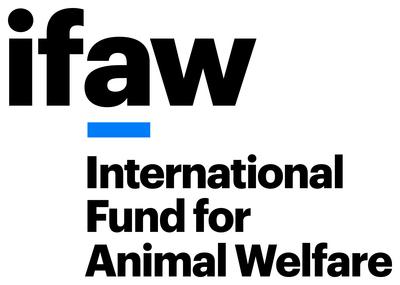IFAW And Local Partners Collaborate To Release A Rescued Jaguar Back Into The Wild
WASHINGTON, Oct. 29, 2020 /PRNewswire/ -- In a milestone example of collaboration between government authorities, the scientific sector, local communities and the International Fund for Animal Welfare (IFAW), a juvenile jaguar has been successfully released back into the wild after being critically injured following a vehicle strike near Chetumal, Mexico on the 11th of June.
The injured male jaguar was transferred to the Payo Obispo Zoo to begin the rehabilitation process where he was monitored and cared for by an extensive multi-disciplinary team that later named him 'Covi'. Upon examination, it was discovered that Covi, estimated to be approximately 18 months old, had sustained a fracture to the left shoulder blade and additional lacerations to his body, though his prognosis was still good. Critical to Covi's recovery was the team's ability to monitor and care for him (following the fracture healing) with minimal human interaction, made possible by a network of cameras and use of spacious enclosures to promote more natural behavior. An advisory group was set up to monitor the rehabilitation process, made up of members from Payo Obispo Zoo, the National Alliance for Jaguar Conservation (ANCJ), the Federal Attorney for Environmental Protection (PROFEPA), the State of Quintana Roo Attorney for Environmental Protection (PPA), the Biodiversity and Natural Protected Areas of the State of Quintana Roo (IBANQROO), and IFAW.
The group determined that the jaguar could indeed be released back into the wild once he began exhibiting signs of a full recovery, including excellent hunting skills. In conjunction with the National Commission for Natural Protected Areas (CONANP), it was decided that the Sian Ka'an Biosphere Reserve would provide the most suitable release location given its abundant prey, access to water, low risk of human conflict, and the general support of the local Xhazil Ejido community.
In the dawn hours of September 22nd, the medical team, which included Dr. Erika Flores, IFAW's Emergency Response and Animal Rescue Coordinator for Latin America, prepared Covi for the 85-mile journey to the Sian Ka'an Reserve. A small team was in place to film the event. Medical tests were conducted and the young male was darted and fitted with a satellite collar that would be used to track future movements after release. He was then placed inside a wooden crate prepared for transport in IFAW's Animal Rescue vehicle, escorted by other vehicles representing all authorities involved in the rescue.
Upon reaching the outskirts of the release area, the team transferred the jaguar to an all-terrain truck to continue the nearly 10-mile journey on muddy roads to the entrance of the reserve. Taking turns in groups of six, the team set out on foot to carry the crate another 400 yards deeper into the jungle to the release site, where a pulley and rope release system was set up to ensure a safe release distance. Biologist and team leader Roger Bragas, Director of Payo Obispo Zoo, pulled the rope that signaled the animal's release. Slowly, Covi emerged and calmly began walking towards the jungle and disappeared within.
According to Joaquin de la Torre, IFAW's Regional Director of Latin America and the Caribbean, "This is the first successful case of a rescue, rehabilitation and release of an injured jaguar back into the wild in the region. It is very uncommon for wildlife to fully recover after being struck by a vehicle. In the rare cases that they do, they are often destined to live in captivity for the remainder of their lives. Jaguar populations in general are on the decline and currently designated 'at risk of extinction' under Mexico's current legislation. Each jaguar matters. We are firm believers that wildlife should remain in the wild to thrive, and we are thrilled that all sides came together to make this a reality."
"The release of this jaguar was a milestone example of coordinated collaboration between Federal, State and Municipal authorities, along with a committed local community and NGOs like IFAW,' remarked Flores. "As a team, we all understand the conservation value of this young jaguar, because we know individual animals matter. We are delighted to have played a role in this successful reintroduction back into the wild where he is now able to thrive once again."
The population of jaguars in Mexico is estimated to number around 4,000 individuals. Covi was discovered in the State of Quintana Roo, where it is believed around 20% of the total population currently resides. According to ANCJ, the population of jaguars in the Yucatán Peninsula is largest and healthiest given the abundance of prey and other biological conditions. The largest wild cat in the Americas, the jaguar faces serious threats resulting from habitat loss and fragmentation, vehicle strikes, conflict due to proximity with humans and domestic animals, as well as the persistent threat of trade in illegal wildlife.
To view video and images documenting the release, please click on the following link.
For more information or to arrange interviews please contact:
Rodger Correa at [email protected].
About the International Fund for Animal Welfare (IFAW) ? The International Fund for Animal Welfare is a global non-profit helping animals and people thrive together. We are experts and everyday people, working across seas, oceans and in more than 40 countries around the world. We rescue, rehabilitate and release animals, and we restore and protect their natural habitats. The problems we're up against are urgent and complicated. To solve them, we match fresh thinking with bold action. We partner with local communities, governments, non-governmental organizations and businesses. Together, we pioneer new and innovative ways to help all species flourish. See how at ifaw.org.
SOURCE International Fund for Animal Welfare
News published on and distributed by:




